Long-Lived Mantle Plume and Polyphase Evolution of Palaeoproterozoic PGE Intrusions in the Fennoscandian Shield
Abstract
:1. Introduction
2. Geological Setting
3. Materials and Methods
3.1. Isotope Analyses
3.2. LA-ICP-MS
4. Results
4.1. Fedorovo-Pansky Massif: U-Pb and Sm-Nd Isotope Data
4.2. Fedorovo Tundra Deposit: Trace Element Compositions
4.3. Penikat (Sompuyarvi reef) and Kemi Intrusions: Sm-Nd and U-Pb Geochronology
5. Discussion
- gravity anomalies caused by a crust-mantle layer at the bottom of the crust;
- riftogenic (anorogenic) structural ensembles with multipath extensional fault tectonics identified by the distribution of grabens and volcanic belts, dike swarms, and intrusive belts;
- protracted polyphase tectonics and magmatism, continental discontinuities and erosion with early stages of tholeiitic-basalt (trappean), boninite-like, and subalkaline magmatism in the continental crust, possible closing stages of the Red Sea-type spreading magmatism;
- intrusive sills, lopoliths, sheet-like bodies, large dikes and dike swarms. The intrusions are often layered and differ from rocks formed in subduction and spreading zones, with trends of thin differentiation layering, limited development of intermediate and felsic rocks, often with leucogabbro and anorthosite ends and abundant pegmatoid mafic varieties;
- typical mantle geochemistry of rocks and ores, as registered by isotope mantle tracers: 143Nd/144Nd, 87Sr/86Sr, 187Os/188Os, and 3He/4He;
Author Contributions
Funding
Acknowledgments
Conflicts of Interest
References
- Bogdanova, S.V.; Bingen, B.; Gorbatschev, R.; Kheraskova, T.N.; Kozlov, V.I.; Puchkov, V.N.; Volozh, Y.U. The East European Craton (Baltica) before and during the assembly of Rodinia. Precambrian Res. 2008, 160, 23–45. [Google Scholar] [CrossRef]
- Slabunov, A.I.; Lobach-Zhuchenko, S.B.; Slabunov, A.I.; Lobach-Zhuchenko, S.B.; Bibikova, E.V.; Sorjonen-Ward, P.; Balagansky, V.V.; Volodichev, O.I.; Shchipansky, A.A.; Svetov, S.A.; et al. The Archaean nucleus of the Fennoscandian (Baltic) Shield. In European Lithosphere Dynamics; Gee, D.G., Stephenson, R.A., Eds.; Geological Society: London, UK, 2006; Volume 32, pp. 627–644. [Google Scholar]
- Bayanova, T.; Mitrofanov, F.; Serov, P.; Nerovich, L.; Yekimova, N.; Nitkina, E.; Kamensky, I. Layered PGE Paleoproterozoic (LIP) Intrusions in the N-E Part of the Fennoscandian Shield—Isotope Nd-Sr and 3He/4He Data, Summarizing U-Pb Ages (on Baddeleyite and Zircon), Sm-Nd Data (on Rock-Forming and Sulphide Minerals), Duration and Mineralization. In Geochronology—Methods and Case Studies/Edited by Nils-Axel Mörner; INTECH: Houston, TX, USA, 2014; pp. 143–193. [Google Scholar] [CrossRef]
- Alapieti, T.T. The Koillismaa layered igneous complex, Finland: Its structure, mineralogy and geochemistry, with emphasis on the distribution of chromium. Geol. Surv. Finl. 1982, 319, 116. [Google Scholar]
- Iljina, M.; Hanski, E. Layered mafic intrusions of the Tornio-Näränkävaara belt. In Precambrian Geology of Finland—Key to the Evolution of the Fennoscandian Shield; Lehtinen, M., Nurmi, P.A., Rämo, O.T., Eds.; Elsevier: Amsterdam, The Netherland, 2005; pp. 101–138. [Google Scholar]
- Vogel, D.C.; Vuollo, J.I.; Alapieti, T.T.; James, R.S. Tectonic, stratigraphic and geochemical comparison between ca. 2500-2440 Ma mafic igneous events in the Canadian and Fennoscandian Shields. Precambrian Res. 1998, 92, 89–116. [Google Scholar] [CrossRef]
- Mitrofanov, F.P.; Balabonin, N.L.; Bayanova, T.B. Main results from the study of the Kola PGE-bearing province, Russia. In Mineral Deposits; Papunen, H., Gorbunov, G.I., Eds.; Balkema: Rotterdam, The Netherlands, 1997; pp. 483–486. [Google Scholar]
- Ernst, R.E. Large Igneous Provinces; Cambridge University Press: Cambridge, UK, 2014; Volume 653. [Google Scholar]
- Mitrofanov, F.P.; Korchagin, A.U.; Dudkin, K.O.; Rundkvist, T.V. Fedorovo-Pana layered mafic intrusion (Kola peninsula, Russia): Approaches, methods and criteria for prospecting PGEs. In Exploration for Platinum-Group Elements Deposits; Short Course Delivered on Behalf of the Mineralogical Association of Canada in Oulu, Finland; University of Toronto: Toronto, ON, Canada, 2005; Volume 35, pp. 343–358. [Google Scholar]
- Schissel, D.; Tsvetkov, A.A.; Mitrofanov, F.P.; Korchagin, A.U. Basal platinum-group element mineralization in the Fedorov Pansky layered mafic intrusion, Kola Peninsula, Russia. Econ. Geol. 2002, 97, 1657–1677. [Google Scholar] [CrossRef]
- Sharkov, Y.V. Formation of Layered Intrusions and Related Mineralization; Scientific World: Moscow, Russia, 2006; p. 364. [Google Scholar]
- Bayanova, T.B.; Ludden, J.; Mitrofanov, F.P. Timing and duration of Palaeoproterozoic events producing ore-bearing layered intrusions of the Baltic Shield: Metallogenic, petrological and geodynamic implications. In Palaeoproterozoic Supercontinents and Global Evolution; Reddy, S.M., Mazumder, R., Evans, D.A.D., Collins, A.S., Eds.; Geological Society: London, UK, 2009; Volume 323, pp. 165–198. [Google Scholar]
- Ekimova, N.A.; Serov, P.A.; Bayanova, T.B.; Elizarova, I.R.; Mitrofanov, F.P. New data on distribution of REEs in sulfide minerals and Sm-Nd dating of ore genesis of layered mafic intrusions. Dokl. Earth Sci. 2011, 436, 28–31. [Google Scholar] [CrossRef]
- Kullerud, K.; Skjerlie, K.P.; Corfu, F.; De La Rosa, J. The 2.40 Ga Ringvassøy mafic dikes, West Troms Basement Complex, Norway: The concluding act of early Palaeoproterozoic continental breakup. Precambrian Res. 2006, 150, 183–200. [Google Scholar] [CrossRef]
- Mitrofanov, F.P.; Bayanova, T.B.; Korchagin, A.U.; Groshev, N.Y.; Malitch, K.N.; Zhirov, D.V.; Mitrofanov, A.F. East Scandinavian and Noril’sk plume mafic Large Igneous Provinces of Pd-Pt ores: Geological and metallogenic comparison. Geol. Ore Depos. 2013, 55, 305–319. [Google Scholar] [CrossRef]
- Balashov, Y.A.; Bayanova, T.B.; Mitrofanov, F.P. Isotope data on the age and genesis of layered mafic-ultramafic intrusions in the Kola Peninsula and northern Karelia, northeastern Baltic Shield. Precambrian Res. 1993, 64, 197–205. [Google Scholar] [CrossRef]
- Zozulya, D.R.; Bayanova, T.B.; Nelson, E.G. Geology and age of the late Archaean Keivy alkaline province, NE Baltic Shield. Geology 2005, 113, 601–608. [Google Scholar] [CrossRef]
- Godel, B.; Barnes, S.-J.; Maier, W.-D. Platinum-group elements in sulphide minerals, platinum-group minerals, and whole-rocks of the Merensky Reef (Bushveld Complex, South Africa): Implications for the formation of the reef. J. Petrol. 2007, 48, 1569–1604. [Google Scholar] [CrossRef]
- Latypov, R.M.; Chistyakova, S.Y. Mechanism for Differentiation of the Western-Pana Layered Intrusion; Publ. of KSC RAS: Apatity, Russia, 2000; Volume 315. [Google Scholar]
- Balabonin, N.L.; Subbotin, V.V.; Skiba, V.I.; Voitekhovsky, Y.L.; Savchenko, E.E.; Pakhomovsky, Y.A. Forms of occurrence and balance of precious metals in the Fedorovo-Pansky intrusion ores (the Kola Peninsula). Obog. Rud. 1998, 6, 24–30. [Google Scholar]
- Subbotin, V.V.; Korchagin, A.U.; Savchenko, E.E. Platinometal mineralization of Fedorovo-Pansky ore region: Type of ore-bearing, mineral composition, particularity of genesis. Vestn. KSC RAS 2012, 1, 55–65. [Google Scholar]
- Krogh, T.E. A low-contamination method for hydro-thermal dissolution of zircon and extraction of U and Pb for isotopic age determinations. Geochim. Cosmochim. Acta 1973, 37, 485–494. [Google Scholar] [CrossRef]
- Ludwig, K.R. PBDAT—A Computer Program for Processing Pb-U-Th Isotope Data; Version 1.22. Open-File Report 88-542; U.S. Geological Survey: Reston, VA, USA, 1991; p. 38.
- Ludwig, K.R. ISOPLOT/Ex—A Geochronological Toolkit for Microsoft Excel; Version 2.05; Berkeley Geochronology Center Special Publication: Berkeley, CA, USA, 1999; Volume 1a, p. 49. [Google Scholar]
- Stacey, J.S.; Kramers, J.D. Approximation of terrestrial lead isotope evolution by a two-stage model. Earth Planet. Sci. Lett. 1975, 26, 207–221. [Google Scholar] [CrossRef]
- Steiger, R.H.; Jäger, E. Subcommission on Geochronology: Convention on the use of decay constants in geo- and cosmochronology. Earth Planet. Sci. Lett. 1977, 36, 359–362. [Google Scholar] [CrossRef]
- Jacobsen, S.B.; Wasserburg, G.J. Sm-Nd isotopic evolution of chondrites and achondrites. II. Earth Planet. Sci. Lett. 1984, 67, 137–150. [Google Scholar] [CrossRef]
- Goldstein, S.J.; Jacobsen, S.B. Nd and Sr isotopic systematics of river water suspended material implications for crystal evolution. Earth Plan. Sci. Lett. 1988, 87, 249–265. [Google Scholar] [CrossRef]
- Zhuravlyov, A.Z.; Zhuravlyov, D.Z.; Kostitsyn, Y.A.; Chernyshov, I.V. Determination of the Sm-Nd ratio for geochronological purposes. Geochemistry 1987, 8, 1115–1129. [Google Scholar]
- DePaolo, D.J. Neodymium isotopes in the Colorado Front Range and crust-mantle evolution in the Proterozoic. Nature 1981, 291, 193–196. [Google Scholar] [CrossRef]
- Liew, I.C.; Hofmann, A.W. Precambrian crustal components, plutonic associations, plate environment of the Hercinian Fold Belt of central Europe: Indications from a Nd and Sr isotopic study. Contrib. Mineral. Petrol. 1988, 98, 129–138. [Google Scholar] [CrossRef]
- Van Achterbergh, E.; Ryanm, C.G.; Griffin, W.L. GLITTER: On-line interactive data reduction for the laser ablation ICP-MS microprobe. In Proceedings of the IX V.M. Goldschmidt Conference, Cambridge, MA, USA, 22–27 August 1999; Lunar and Planetary Institute Contribution No. 791: Houston, TX, USA, 1999; Volume 305. [Google Scholar]
- Ekimova, N.A.; Serov, P.A.; Bayanova, T.B.; Yelizarova, I.R.; Mitrofanov, F.P. The REE distribution in sulphide minerals and Sm-Nd age determination for the ore-forming processes in mafic layered intrusions. Dokl. RAS 2011, 436, 75–78. [Google Scholar]
- Nitkina, E.A. U-Pb zircon dating of rocks of the platiniferous Fedorova-Pana Layered Massif, Kola Peninsula. Dokl. Earth Sci. 2006, 408, 551–554. [Google Scholar] [CrossRef]
- Serov, P.A.; Nitkina, E.A.; Bayanova, T.B.; Mitrofanov, F.P. Comparison of the new data on dating using U-Pb and Sm-Nd isotope methods of early barren phase rocks and basal ore-hosting rocks of the Pt-bearing Fedorovo-Pansky layered intrusion (Kola peninsula). Dokl. Earth Sci. 2007, 415, 1–3. [Google Scholar]
- Faure, G. Principles of Isotope Geology; Wiley: New York, NY, USA, 1986; Volume 460. [Google Scholar]
- Eisele, J.; Sharma, M.; Galer, S.J.G. The role of sediment recycling in EM-1 inferred from Os, Pb, Hf, Nd, Sr isotope and trace element systematic of the Pitcairn Hotspot, Earth Planet. Sci. Lett. 2002, 196, 197–212. [Google Scholar] [CrossRef]
- Hofmann, A.W. Mantle geochemistry: The message from oceanic volcanism. Nature 1997, 385, 219–229. [Google Scholar] [CrossRef]
- Yang, S.-H.; Hanski, E.; Li, C.; Maier, W.-D.; Huhma, H.; Mokrushin, A.V.; Latypov, R.; Lahaye, Y.; O’Brien, H.; Qu, W.-J. Mantle source of the 2.44–2.50 Ga mantle plume-related magmatism in the Fennoscandian Shield: Evidence from Os, Nd and Sr isotope compositions of the Monchepluton and Kemi intrusions. Miner. Depos. 2016, 51, 20. [Google Scholar] [CrossRef]
- Mitrofanov, F.; Golubev, A. Russian Fennoscandian metallogeny. In Proceedings of the Abstracts of the 33 IGC, Oslo, Norway, 6–14 August 2008. [Google Scholar]
- Richardson, S.H.; Shirey, S.B. Continental mantle signature of Bushveld magmas and coeval diamonds. Nature 2008, 453, 910–913. [Google Scholar] [CrossRef] [PubMed]
- Maier, W.-D.; Halkoaho, T.; Huhma, H.; Hanski, E.; Barnes, S.-J. The Penikat Intrusion, Finland: Geochemistry, geochronology, and origin of platinum-palladium reefs. J. Petrol. 2018, 59, 967–1006. [Google Scholar] [CrossRef]
- Perttunen, V.; Vaasjoki, M. U-Pb geochronology of the Peräpohja Schist Belt, northwestern Finland. In Radiometric Age Determinations from Finnish Lapland and Their Bearing on the Timing of Precambrian Volcano-Sedimentary Sequences; Vaasjoki, M., Ed.; Special Paper 33; Geological Survey of Finland: Espoo, Finland, 2001; pp. 45–84. [Google Scholar]
- Mitrofanov, F.P.; Bayanova, T.B. Duration and timing of ore-bearing Palaeoproterozoic intrusions of Kola province. In Mineral Deposits: Processes to Processing; Stanley, C.J., Ed.; Balkema: Rotterdam, The Netherlands, 2002; pp. 1275–1278. [Google Scholar]
- Amelin, Y.V.; Heaman, L.M.; Semenov, V.S. U-Pb geochronology of layered mafic intrusions in the eastern Baltic Shield: Implications for the timing and duration of Palaeoproterozoic continental rifting. Precambrian Res. 1995, 75, 31–46. [Google Scholar] [CrossRef]
- Kramm, U. Mantle components of carbonatites from the Kola Alkaline Province, Russia and Finland: A Nd-Sr study. Eur. J. Mineral. 1993, 5, 985–989. [Google Scholar] [CrossRef]
- Heaman, L.M.; Le Cheminant, A.N. Paragenesis and U-Pb systematics of baddeleyite (ZrO). Chem. Geol. 1993, 110, 95–126. [Google Scholar] [CrossRef]
- Fischer-Godde, M.; Becker, H.; Wombacher, F. Rhodium, gold and other highly siderophile element abundances in chondritic meteorites. Geochim. Cosmochim. Acta 2010, 74, 356–379. [Google Scholar] [CrossRef]
- Lyubetskaya, T.; Korenaga, J. Chemical composition of Earth’s primitive mantle and its variance: 2. Implications for global geodynamics. J. Geophys. Res. 2007, 112. [Google Scholar] [CrossRef]
- Lyubetskaya, T.; Korenaga, J. Chemical composition of Earth’s primitive mantle and its variance: 1. Method and results. J. Geophys. Res. 2007, 112. [Google Scholar] [CrossRef]
- Amelin, Y.V.; Semenov, V.S. U-Nd and Sr isotopic deochemistry of mafic layered intrusions in the eastern Baltic Shield: Implications for the evolution of Paleoproterozoic continental mafic magmas. Contrib. Mineral. Petrol. 1996, 124, 255–272. [Google Scholar] [CrossRef]
- Bayanova, T.B.; Smolkin, V.F.; Levkovich, N.V. U-Pb geochronological study of Mount Generalskaya layered intrusion, northwestern Kola Peninsula, Russia. In Transactions of the Institution of Mining and Metallurgy; Institution of Mining and Metallurgy: Vladikavkaz, Russia, 1999; Volume 108, pp. B83–B90. [Google Scholar]
- Tolstikhin, I.N.; Dokuchaeva, V.S.; Kamensky, I.L.; Amelin, Y.V. Juvenile helium in ancient rocks: II. U-He, K-Ar, Sm-Nd, and Rb-Sr systematics in the Monchepluton. 3He/4He ratios frozen in uranium-free ultramafic rocks. Geochim. Cosmochim. Acta 1992, 56, 987–999. [Google Scholar] [CrossRef]
- Vrevsky, A.B.; Levchenkov, O.A. Geological-geochronological scale of the endogenous processes operated within the Precambrian complexes of the central part of the Kola Peninsula. In Geodynamics and Deep Structure of the Soviet Baltic Schield; Mitrofanov, F.P., Bolotov, V.I., Eds.; KSС RAS: Apatity, Russia, 1992; Volume 150. [Google Scholar]
- Mitrofanov, F.P.; Balagansky, V.V.; Balashov, Y.A.; Gannibal, L.F.; Dokuchaeva, V.S.; Nerovich, L.I.; Radchenko, M.K.; Ryungenen, G.I. U-Pb age for gabbro-anorthosite of the Kola Peninsula. Dokl. RAS 1993, 331, 95–98. [Google Scholar]
- Bayanova, T.B. Baddeleyite: A promising geochronometer for alkaline and basic magmatism. Petrology 2006, 14, 187–200. [Google Scholar] [CrossRef]
- Huhma, H.; Cliff, R.; Perttunen, V.; Sakko, M. Sm-Nd and Pb isotopic study of mafic rocks associated with early Proterozoic continental rifting: The Perapohja schist belt in northern Finland. Contrib. Mineral. Petrol. 1990, 104, 369–379. [Google Scholar] [CrossRef]
- Alapieti, T.T.; Filen, B.A.; Lahtinen, J.J.; Lavrov, M.M.; Smolkin, V.F.; Voitekhovsky, Y.L. Early Proterozoic layered intrusions in the Northeastern part of the Fennoscandian Shield. Contrib. Mineral. Petrol. 1990, 42, 1–22. [Google Scholar] [CrossRef]
- Hanski, E.; Walker, R.J.; Huhma, H.; Suominen, I. The Os and Nd isotopic systematics of c. 2.44 Ga Akanvaara and Koitelainen mafic layered intrusions in northern Finland. Precambrian Res. 2001, 109, 73–102. [Google Scholar] [CrossRef]
- Bayanova, T.B.; Mitrofanov, F.P. Layered Proterozoic PGE intrusions in Kola region: New isotope data. In Proceedings of the Extended abstracts of the X International Symp. Platinum “Platinum-Group Elements—From Genesis to Beneficiation and Environmental Impact”, Oulu, Finland, 8–11 August 2005; pp. 289–291. [Google Scholar]
- Nerovich, L.I.; Bayanova, T.B.; Serov, P.A.; Elizarov, D.V. Magmatic sources of dikes and veins in the Moncha Tundra Massif, Baltic Shield: Isotopic-geochronologic and geochemical evidence. Geochem. Intern. 2014, 52, 548–566. [Google Scholar] [CrossRef]
- Rundkist, T.V.; Bayanova, T.B.; Sergeev, S.A.; Pripachkin, P.V.; Grebnev, P.A. The Paleoproterozoic Vurechuaivench layered Pt-bearing pluton, Kola Peninsula: New results of the U-Pb (ID-TIMS, SHRIMP) dating of baddeleyite and zircon. Dokl. Earth Sci. 2014, 454, 1–6. [Google Scholar] [CrossRef]
- Mitrofanov, F.P.; Bayanova, T.B.; Zhirov, D.V.; Serov, P.A.; Golubev, A. Geological and isotope-geochemical characteristics of prediction and search method for the PGE-bearing mafic-ultramafic layered intrusions of the East-Scandinavian LIP. In Proceedings of the Abstracts of the XII Intern. Platinum Symp., Yekaterinburg, Russia, 11–14 August 2014; pp. 113–114. [Google Scholar]
- Chistyakov, A.V.; Bogatikov, O.A.; Grochovskaya, T.L.; Sharkov, E.V.; Belyatskiy, B.V.; Ovchinnikova, G.V. Burakovskiy layered pluton (S. Karelia) as a result of space combination double intrusive bodies: Petrological and isotope-geochemical data. Dokl. RAS 2000, 372, 228–235. [Google Scholar]
- Gorbatschev, R.; Bogdanova, S. Frontiers in the Baltic Shield. Precambrian Res. 1993, 64, 3–21. [Google Scholar] [CrossRef]
- Vuollo, J.I.; Huhma, H. Palaeoproterozoic mafic dikes in NE Finland. In Precambrian Geology of Finland; Lehtinen, M., Nurmi, P.A., Rämö, O.T., Eds.; Elsevier: Amsterdam, The Netherlands, 2005; pp. 195–236. [Google Scholar]
- Vuollo, J.I.; Huhma, H.; Stepana, V.; Fedotov, G.A. Geochemistry and Sm-Nd isotope studies of a 2.45 Ga dike swarm: Hints at parental magma compositions and PGE potential to Fennoscandian layered intrusions. In Proceedings of the IX Intern. Platinum Symp., Billings, MT, USA, 21–25 July 2002; pp. 469–470. [Google Scholar]
- Coffin, M.F.; Eldholm, O. Large igneous provinces: Crustal structure, dimensions and external consequences. Rev. Geophys. 1994, 32, 1–36. [Google Scholar] [CrossRef]
- Ernst, R.E.; Buchan, K.L. Recognizing mantle plumes in the Geological Record. Earth Planet. Sci. 2003, 31, 469–523. [Google Scholar] [CrossRef]
- Pirajno, F. Mantle plumes, associated intraplate tectono-magmatic processes and ore systems. Episodes 2007, 30, 6–19. [Google Scholar]
- Tolstikhin, I.N.; Marty, B. The evolution of terrestrial volatiles: A view from helium, neon, argon and nitrogen isotope modeling. Chem. Geol. 1998, 147, 27–52. [Google Scholar] [CrossRef]
- Bleeker, W.; Ernst, R. Short-lived mantle generated magmatic events and their dike swarms: The key unlocking Earth’s Paleogeographic record back to 2.6 Ga. In Dike Swarms-Time Marker of Crustal Evolution; Balkema Publishers: Zürich, Switzerland, 2006; pp. 1–20. [Google Scholar]
- Campbell, I.H. Identification of ancient mantle plumes. In Mantle Plumes: Their Identification Through Time; Ernst, R.E., Buchan, K.L., Eds.; Geological Society of America: Boulder, CO, USA, 2001; Volume 352, pp. 5–22. [Google Scholar]
- Heaman, L.M. Global mafic magmatism at 2.45 Ga: Remnants of an ancient large igneous province? Geology 1997, 25, 299–302. [Google Scholar] [CrossRef]
- Bogatikov, O.A.; Kovalenko, V.I.; Sharkov, Y.V. Magmatism, Tectonics, and Geodynamics of the Earth; Nauka: Moscow, Russia, 2010; 606p. [Google Scholar]
- Grachyov, A.F. Identification of mantle plumes on the basis of studying composition and isotope geochemistry of volcanic rocks. Petrology 2003, 11, 618–654. [Google Scholar]
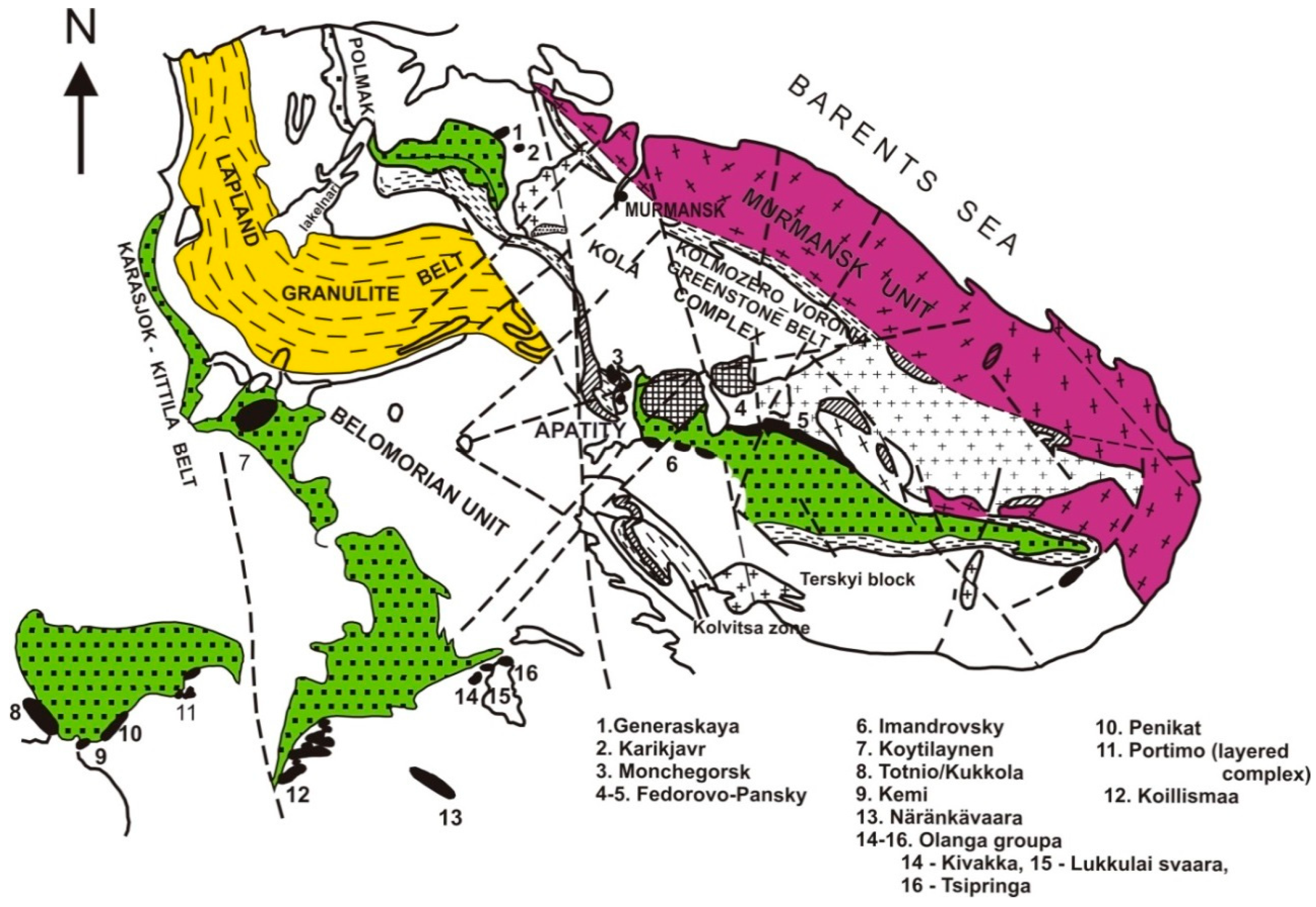

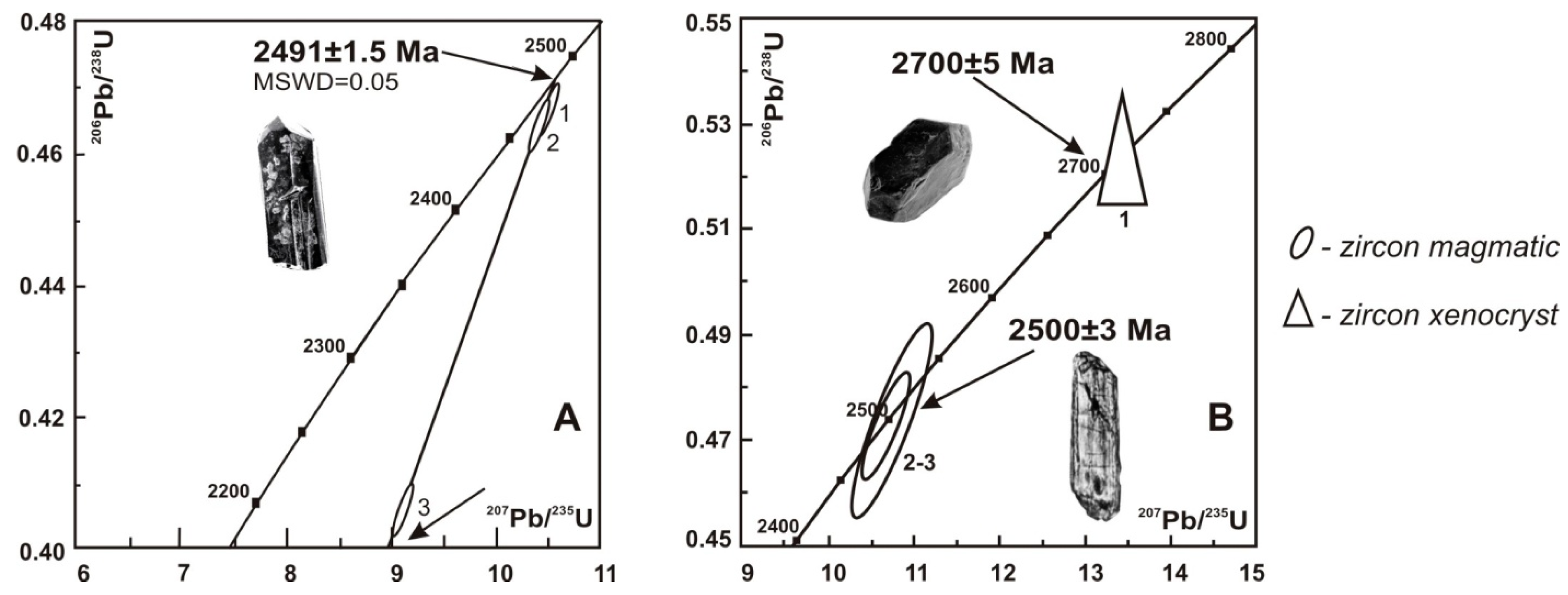
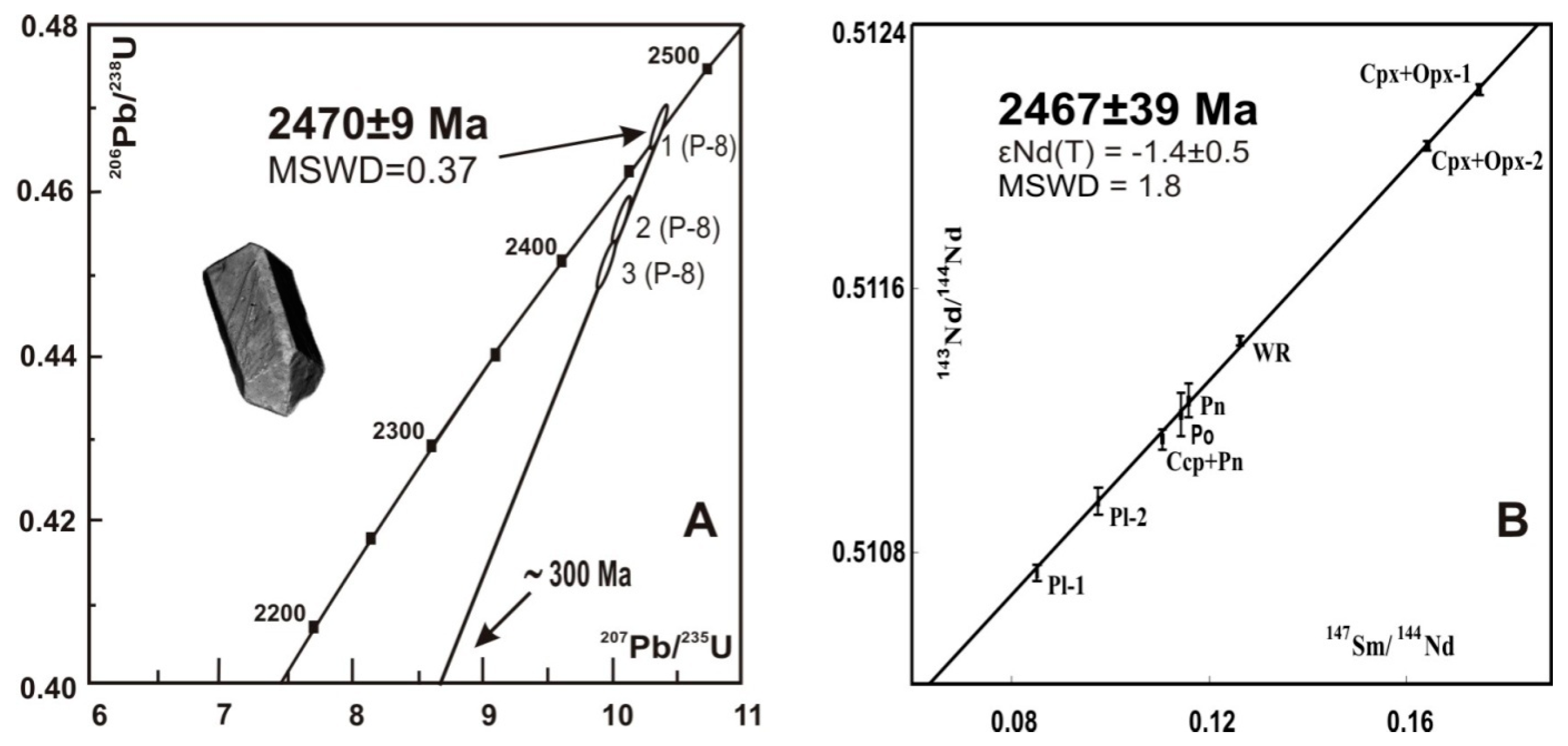
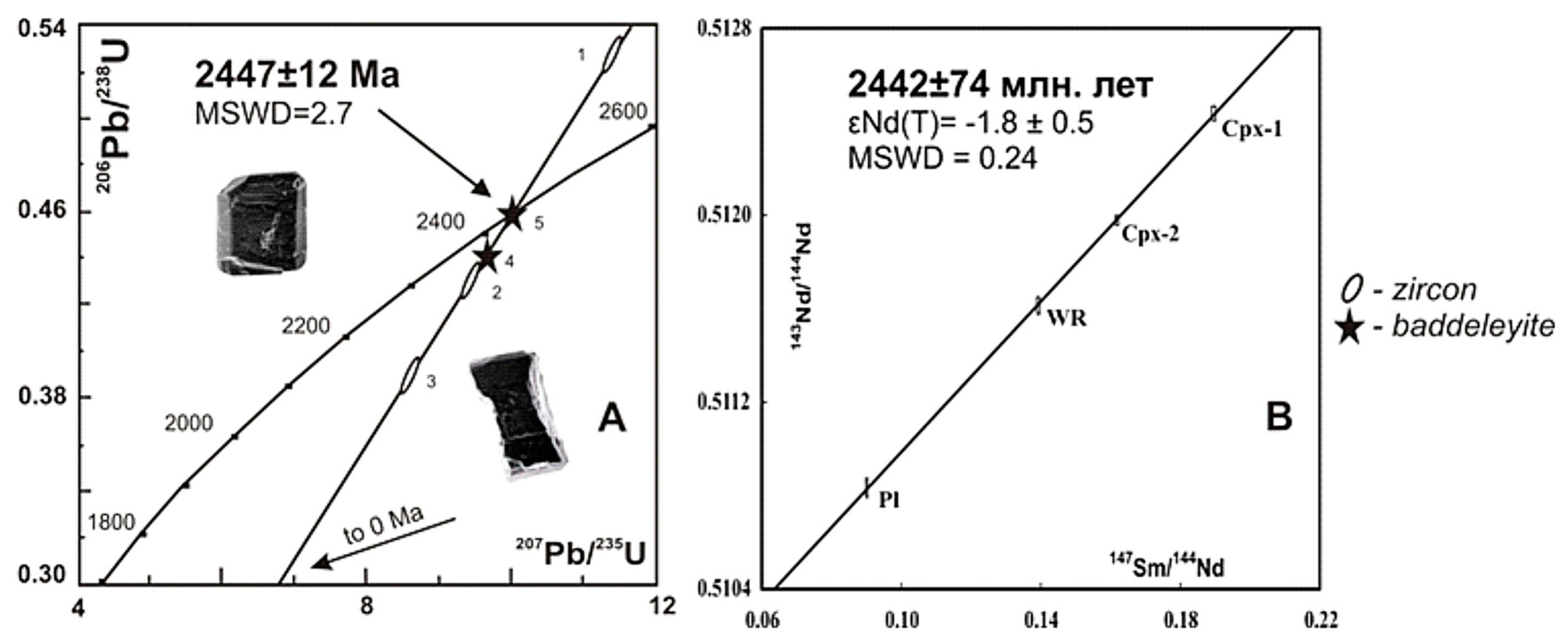
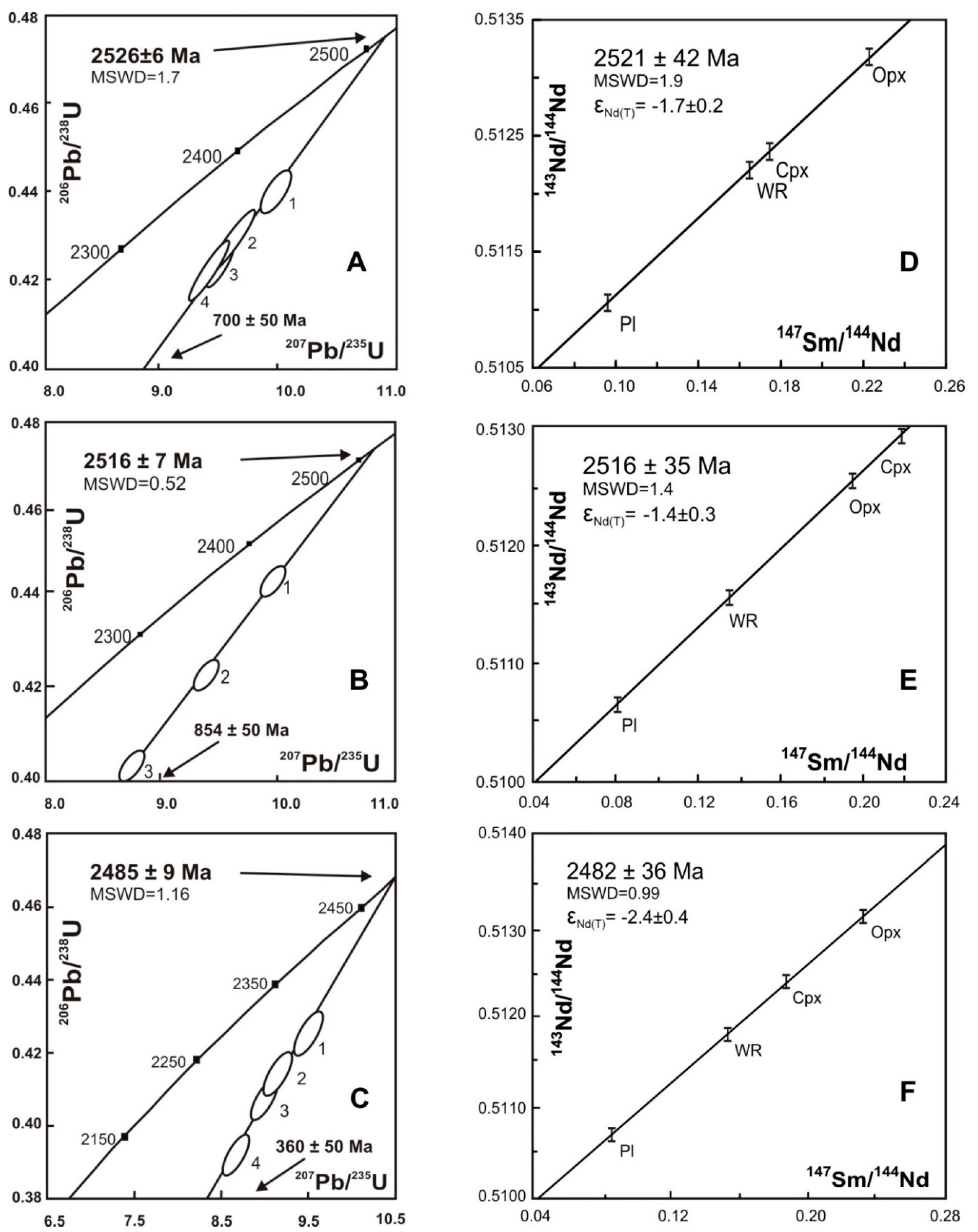
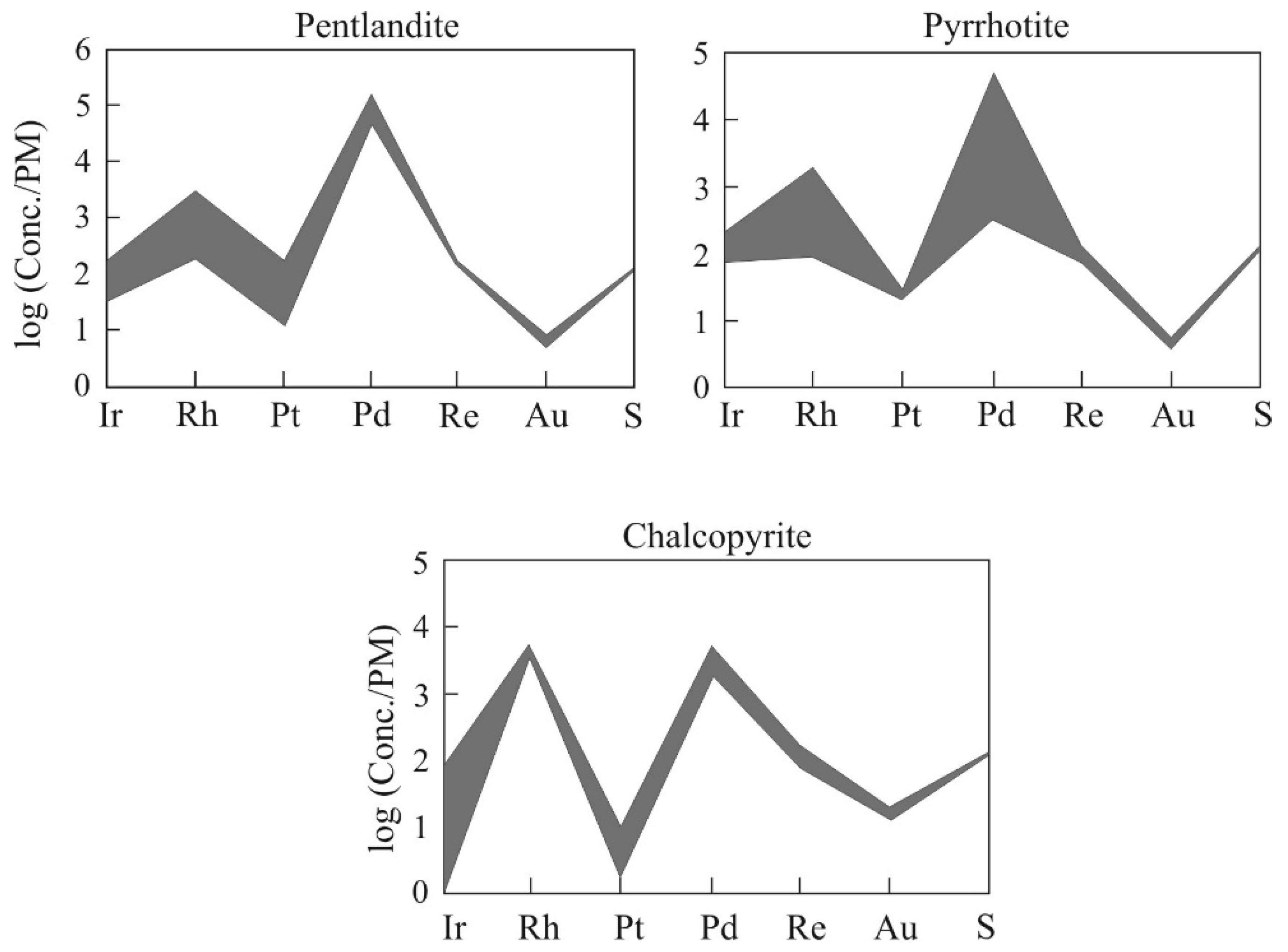
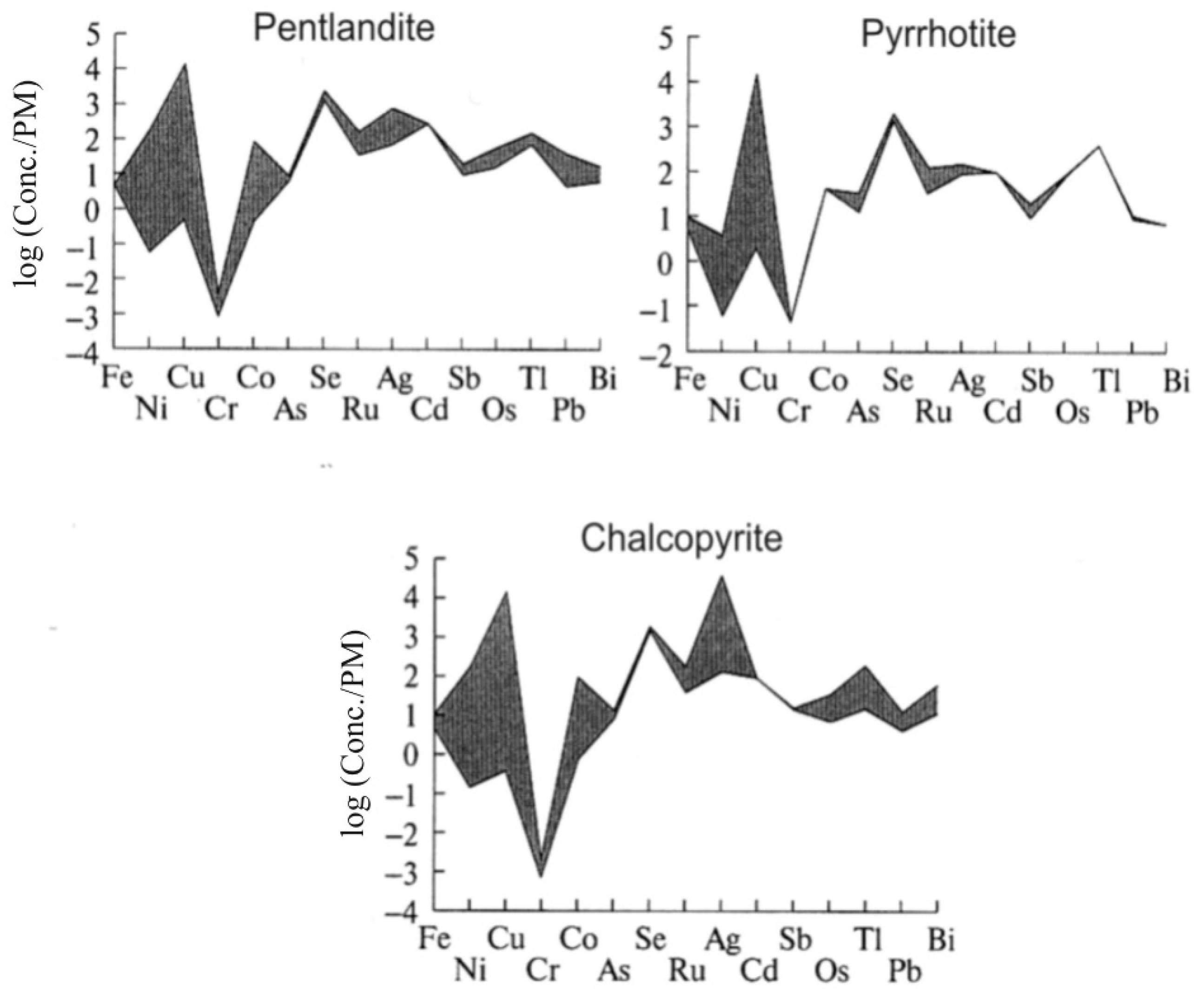

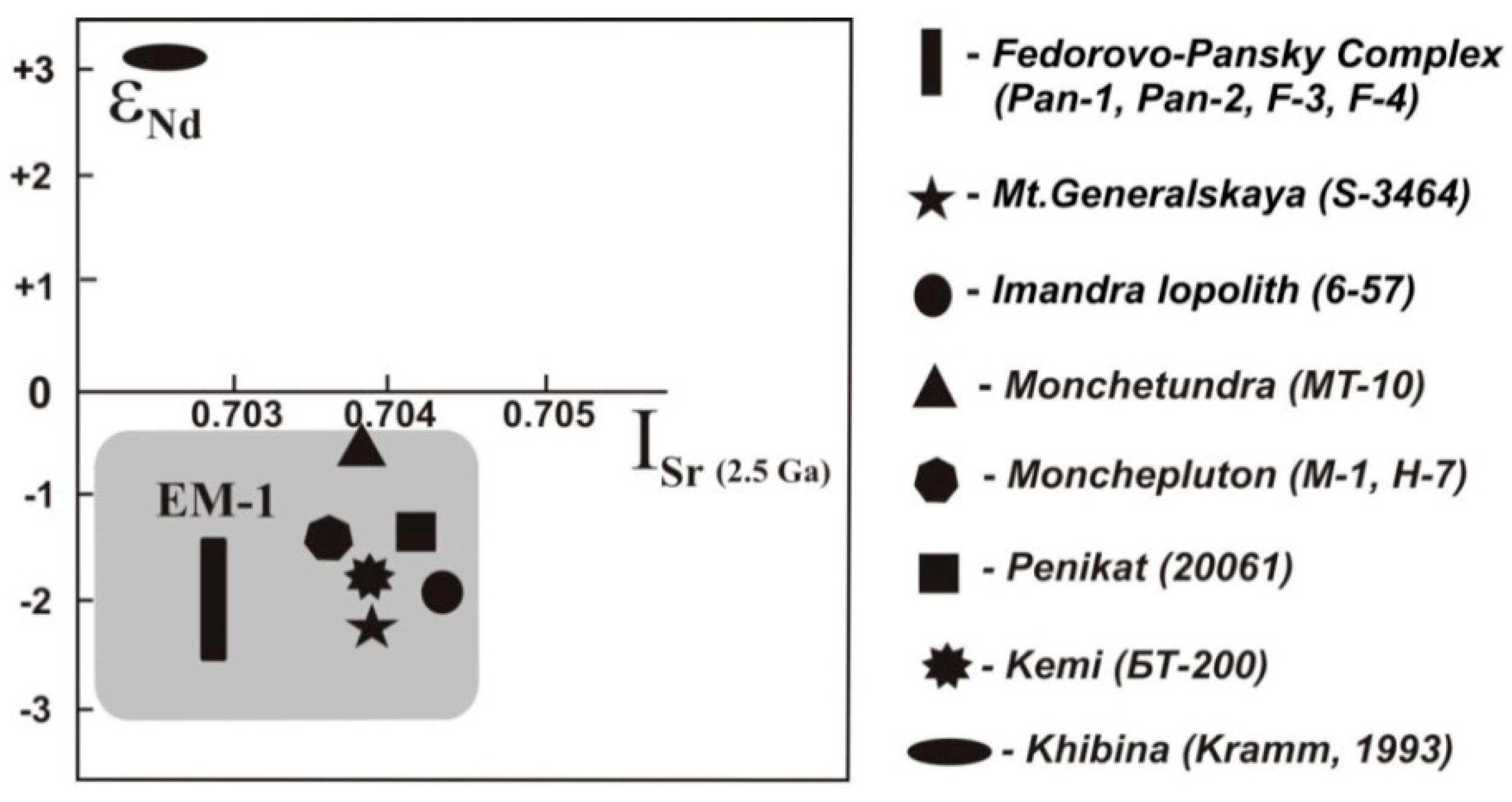
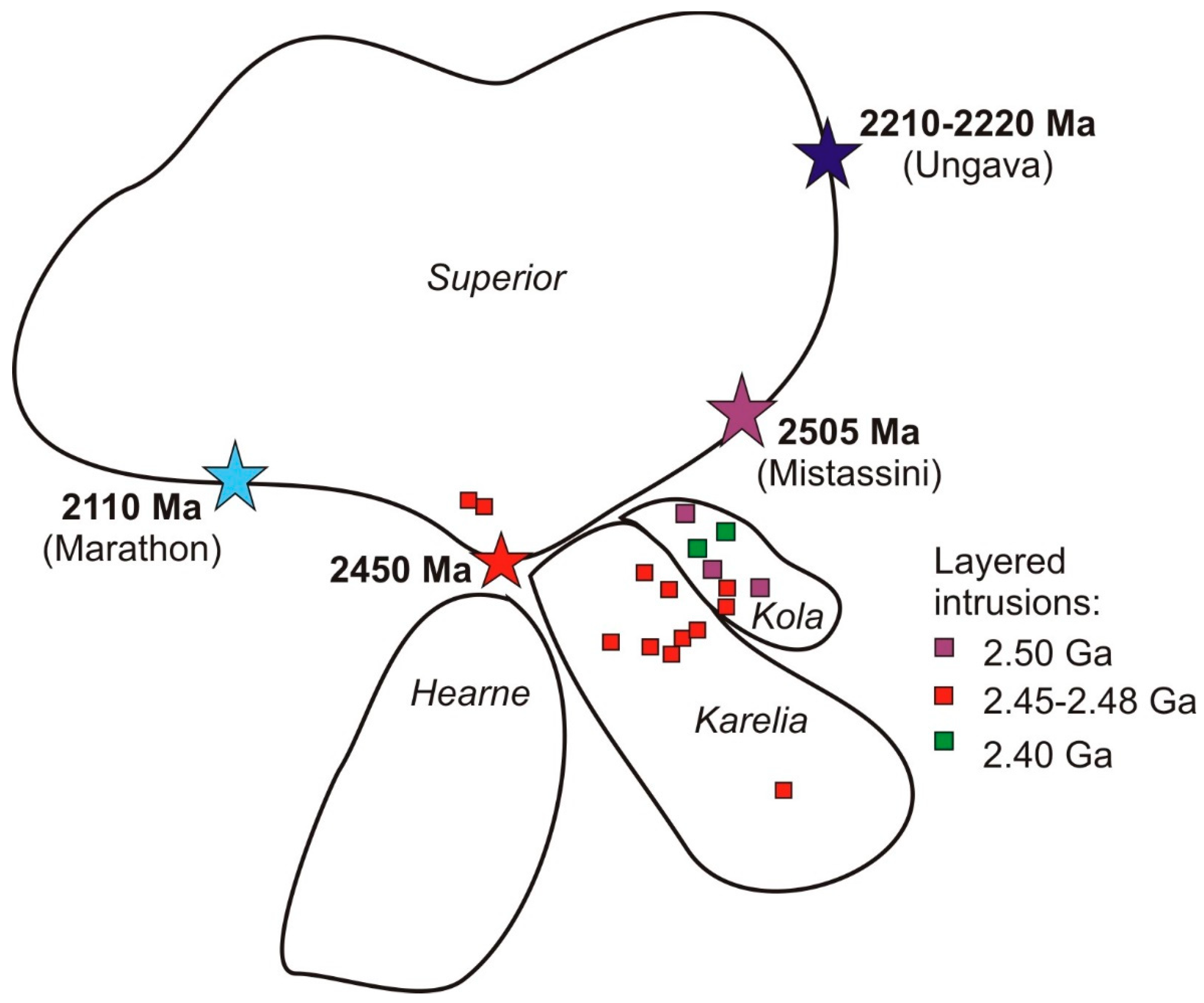
| Sample No | Weight (mg) | Content (ppm) | Pb Isotope Composition 1 | Isotope Ratios 2 | Age 2 (Ma) | ||||
|---|---|---|---|---|---|---|---|---|---|
| Pb | U | 206Pb 204Pb | 206Pb 207Pb | 206Pb 208Pb | 207Pb 235U | 206Pb 238U | 207Pb 206Pb | ||
| Western-Pansky Block, gabbronorites (Pan-1) | |||||||||
| 1 | 3.30 | 95.0 | 144 | 11740 | 6.091 | 3.551 | 10.510 | 0.4666 | 2491 |
| 2 | 1.60 | 84.0 | 144 | 6720 | 6.062 | 3.552 | 10.473 | 0.4650 | 2491 |
| 3 | 1.90 | 70.0 | 142 | 10300 | 6.100 | 4.220 | 9.135 | 0.4061 | 2489 |
| Western-Pansky Block, gabbropegmatite (P-8) | |||||||||
| 1 | 5.90 | 95.0 | 158 | 3240 | 5.991 | 3.081 | 10.435 | 0.4681 | 2471 |
| 2 | 7.30 | 181.0 | 287 | 8870 | 6.161 | 2.260 | 10.092 | 0.4554 | 2465 |
| 3 | 1.25 | 125.0 | 200 | 3400 | 6.012 | 2.312 | 10.082 | 0.4532 | 2468 |
| Western-Pansky Block, anorthosite (P-6) | |||||||||
| 1 | 0.75 | 218.0 | 322 | 5740 | 6.230 | 3.263 | 11.682 | 0.5352 | 2438 |
| 2 | 0.10 | 743.0 | 1331 | 3960 | 6.191 | 3.151 | 9.588 | 0.4393 | 2438 |
| 3 | 0.20 | 286.0 | 577 | 2980 | 6.021 | 3.192 | 8.643 | 0.3874 | 2474 |
| 4 (bd) | 1.00 | 176.0 | 396 | 14780 | 6.290 | 63.610 | 9.548 | 0.4380 | 2435 |
| 5(bd) | 0.26 | 259.0 | 560 | 3360 | 6.132 | 54.950 | 9.956 | 0.4533 | 2443 |
| Fedorov Block, orthopyroxenite (F-3) | |||||||||
| 1 | 0.75 | 48.0 | 60.9 | 825 | 4.9191 | 1.3039 | 10.0461 | 0.44249 | 2504 |
| 2 | 0.80 | 374.0 | 598.6 | 4588 | 6.0459 | 1.9650 | 9.6782 | 0.43153 | 2484 |
| 3 | 0.85 | 410.2 | 630.2 | 4521 | 6.0281 | 1.6592 | 9.5667 | 0.42539 | 2488 |
| 4 | 1.00 | 271.0 | 373.1 | 2552 | 5.9916 | 1.2393 | 9.4700 | 0.42406 | 2476 |
| Fedorov Block, olivine gabbro (F-4) | |||||||||
| 1 | 1.80 | 725.3 | 1322.8 | 14649 | 6.1121 | 3.8177 | 10.0132 | 0.44622 | 2484 |
| 2 | 2.00 | 731.3 | 1382.8 | 8781 | 6.1522 | 3.5517 | 9.4306 | 0.42454 | 2467 |
| 3 | 1.95 | 680.9 | 1374.0 | 7155 | 6.2645 | 3.6939 | 8.7401 | 0.40155 | 2433 |
| Fedorov Block, PGE-bearing gabbronorite (F-2) | |||||||||
| 1 | 0.30 | 498.0 | 833.4 | 2081 | 5.9502 | 2.2111 | 9.49201 | 0.42493 | 2477 |
| 2 | 0.65 | 513.8 | 932.2 | 5274 | 6.1519 | 2.6371 | 9.1373 | 0.41378 | 2458 |
| 3 | 0.55 | 583.2 | 999.3 | 3194 | 6.1132 | 2.0528 | 8.9869 | 0.40832 | 2452 |
| 4 | 0.80 | 622.5 | 1134.5 | 4114 | 6.1161 | 2.1914 | 8.6638 | 0.39165 | 2460 |
| No. | Weight mg | Content (ppm) | Isotope Composition 1 | Isotope Ratios and Age in Ma 2 | % Dis | ||||||
|---|---|---|---|---|---|---|---|---|---|---|---|
| Pb | U | 206Pb/204Pb | 206Pb/238U ± 2σ | 207Pb/235 U ± 2σ | 207Pb/206Pb ± 2σ | 206Pb/238U ± 2σ | 207Pb/235U ± 2σ | 207Pb/206Pb ± 2σ | |||
| 1 | 0.0457 | 21.20 | 6.33 | 833.59 | 0.521 ± 0.018 | 13.327 ± 0.634 | 0.186 ± 0.006 | 2702 ± 95 | 2703 ± 129 | 2704 ± 82 | 0.1 |
| 2 | 0.0536 | 12.87 | 5.92 | 461.17 | 0.474 ± 0.015 | 10.768 ± 0.393 | 0.165 ± 0.003 | 2499 ± 80 | 2503 ± 91 | 2507 ± 42 | 0.3 |
| 3 | 0.0567 | 16.10 | 10.96 | 111.20 | 0.472 ± 0.008 | 10.688 ± 0.215 | 0.164 ± 0.002 | 2495 ± 42 | 2496 ± 50 | 2498 ± 26 | 0.1 |
| Sample No. | Content, ppm | Isotope Ratios | TDM, Ma | εNd(T) | ||
|---|---|---|---|---|---|---|
| Sm | Nd | 147Sm/144Nd | 143Nd/144Nd | |||
| Gabbro-pegmatite LLH | ||||||
| WR | 1.038 | 4.99 | 0.1263 | 0.511441 ± 10 | 2967 | −1.3 |
| Po | 0.033 | 0.147 | 0.1144 | 0.511217 ± 69 | ||
| Pn | 0.011 | 0.041 | 0.1160 | 0.511259 ± 53 | ||
| Pl-1 | 0.332 | 2.30 | 0.0853 | 0.510738 ± 24 | ||
| Pl-2 | 0.398 | 2.25 | 0.0977 | 0.510957 ± 39 | ||
| Cpx + Opx-1 | 4.75 | 16.44 | 0.1747 | 0.512209 ± 7 | ||
| Cpx + Opx-2 | 2.54 | 9.34 | 0.1641 | 0.512033 ± 9 | ||
| Ccp + Pn | 0.022 | 0.124 | 0.1106 | 0.511143 ± 27 | ||
| Sample No. | Content, ppm | Isotope Ratios | TDM, Ma | εNd(T) | ||
|---|---|---|---|---|---|---|
| Sm | Nd | 147Sm/144Nd | 143Nd/144Nd | |||
| ULH anorthosite | ||||||
| WR | 0.271 | 1.176 | 0.1393 | 0.511613 ± 34 | 3131 | −0.8 |
| Pl | 0.107 | 0.719 | 0.0901 | 0.510833 ± 39 | ||
| Cpx-1 | 0.921 | 2.94 | 0.1896 | 0.512436 ± 32 | ||
| Cpx-2 | 0.801 | 2.99 | 0.1618 | 0.511978 ± 20 | ||
| Sample No. | Content (ppm) | Isotope Ratios | TDM (Ga) | Sm-Nd (Ma) | εNd (2.5Ga) | ||
|---|---|---|---|---|---|---|---|
| Sm | Nd | 147Sm/144Nd | 143Nd/144Nd | ||||
| D-orthopyroxenite (F-3) | |||||||
| WR | 0.32 | 1.17 | 0.1648 | 0.512196 ± 12 | 3.05 | 2521 ± 42 | −1.73 |
| Opx | 0.12 | 0.38 | 0.2228 | 0.513182 ± 16 | |||
| Cpx | 2.21 | 7.67 | 0.1745 | 0.512349 ± 17 | |||
| Pl | 0.26 | 1.62 | 0.0960 | 0.511071 ± 29 | |||
| E-olivine gabbro (F-4) | |||||||
| WR | 0.63 | 2.80 | 0.1357 | 0.511548 ± 8 | 2.94 | 2516 ± 35 | −1.53 |
| Opx | 0.23 | 0.72 | 0.1951 | 0.512555 ± 15 | |||
| Cpx | 0.83 | 2.28 | 0.2187 | 0.512947 ± 16 | |||
| Pl | 0.24 | 1.77 | 0.0815 | 0.510677 ± 14 | |||
| F-PGE-bearing gabbronorite (F-2) | |||||||
| WR | 0.42 | 1.66 | 0.1537 | 0.511807 ± 20 | 3.18 | 2482 ± 36 | −2.50 |
| Pl | 0.41 | 2.88 | 0.0865 | 0.510709 ± 14 | |||
| Cpx | 1.78 | 5.73 | 0.1876 | 0.512387 ± 8 | |||
| Opx | 0.13 | 0.33 | 0.2323 | 0.513088 ± 40 | |||
| Sample | Mineral | Number of Analyses | Cr | Co | As | Se | Ru | Rh | Pd | Ag | Cd | Sb | Re | Os | Ir | Pt | Au | Tl | Pb | Bi |
|---|---|---|---|---|---|---|---|---|---|---|---|---|---|---|---|---|---|---|---|---|
| 237/132.0 | Pentlandite | 8 | 2.8–16.5 | 6811–10681 | 0.3–0.7 | 92–183 | 0.5–1.0 | 0.1–6.9 | 258–1221 | 0.4–5.8 | - | 0.1–0.1 | - | 0.1 | 0.01–0.2 | 0.01–1.2 | 0.01 | 0.1–0.8 | 0.2–8.1 | 0.02–0.2 |
| Chalcopyrite | 6 | 2.8 | 0.3–142 | 0.3 | 178 | 0.2 | 0.1–9.1 | 19 | 0.2–5.3 | 14 | 0.1–0.2 | 0.02 | 0.1 | 0.3 | 0.01 | 0.03 | - | 4.5–8.0 | - | |
| 487/50.5 | Pentlandite | 10 | 0.9–5.9 | 8395 | 0.3–0.4 | 99 | 0.8 | 1.5–9.1 | 442 | 0.7 | - | 0.1 | 0.05 | 0.1–0.3 | 0.6 | 0.03–0.2 | - | 0.1–0.4 | 0.1–2.3 | 0.02 |
| Pyrrhotite | 8 | 0.6–453 | 59–15612 | 0.2–2.5 | 102–222 | 0.3–1.5 | 1.2–2.9 | 0.1–636 | 0.1–1.6 | - | 0.1 | 0.03–0.09 | 0.2–0.6 | 0.6–1.1 | 0.2 | 0.01 | 0.1–1.4 | 0.1–5.8 | 0.01–0.04 | |
| Chalcopyrite | 5 | - | - | 0.5–0.7 | 98 | 0.2 | 8.8 | 18 | 0.4 | 5 | 0.1 | - | - | - | - | - | - | 1.5 | - | |
| 495/76.5 | Pentlandite | 10 | 2.0 | 5499–12079 | 0.4 | 118 | 0.6–1.2 | 0.1–0.6 | 247–1487 | 0.3–1 | - | 0.1 | - | 0.2 | 0.3 | 0.2–2 | 0.01 | 0.1–0.9 | 0.1–1.5 | 0.03–0.1 |
| Pyrrhotite | 9 | 0.7–15 | 66–119 | - | 132 | 0.2 | 0.1–0.2 | 0.1–4 | 0.4–2 | - | 0.1 | 0.03 | 0.1 | 0.1–0.3 | 0.04–0.3 | 0.01 | 0.02–0.05 | 0.1–6.3 | 0.02–0.6 | |
| Chalcopyrite | 8 | 2.6 | 0.5–487 | 0.7 | 142 | 0.1–0.2 | 11 | 23–125 | 0.6–1133 | 2–9 | - | 0.04 | - | 0.02 | 0.02–0.1 | 0.02 | 0.04–0.7 | 0.6–4.1 | 0.04–0.2 |
| No. | Weight mg | Content (ppm) | Isotope Composition 1 | Isotope Ratios and Age in Ma 2 | % Dis | ||||||
|---|---|---|---|---|---|---|---|---|---|---|---|
| Pb | U | 206Pb/204Pb | 206Pb/238U ± 2σ | 207Pb/235 U ± 2σ | 207Pb/206Pb ± 2σ | 206Pb/238U ± 2σ | 207Pb/235U ± 2σ | 207Pb/206Pb ± 2σ | |||
| Gabbronorite of Penikat | |||||||||||
| 1 | 0.1360 | 24.87 | 33.26 | 260.12 | 0.458 ± 0.004 | 9.929 ± 0.138 | 0.157 ± 0.002 | 2429 ± 21 | 2428 ± 34 | 2428 ± 24 | −0.04 |
| 2 | 0.1840 | 28.14 | 42.74 | 254.48 | 0.457 ± 0.004 | 9.845 ± 0.138 | 0.156 ± 0.002 | 2426 ± 21 | 2420 ± 34 | 2416 ± 24 | −0.41 |
| Gabbronorite of Kemi | |||||||||||
| 1 | 0.027 | 13.84 | 18.52 | 358.23 | 0.463 ± 0.009 | 10.155 ± 0.205 | 0.1592 ± 0.0005 | 2452 ± 49 | 2449 ± 49 | 2447 ± 7 | −0.2 |
| 2 | 0.057 | 13.61 | 19.18 | 758.23 | 0.459 ± 0.009 | 10.069 ± 0.202 | 0.1592 ± 0.0005 | 2434 ± 48 | 2441 ± 49 | 2447 ± 7 | 0.5 |
| 3 | 0.032 | 11.51 | 16.10 | 404.27 | 0.453 ± 0.009 | 9.948 ± 0.196 | 0.1592 ± 0.0005 | 2410 ± 47 | 2430 ± 48 | 2447 ± 7 | 1.3 |
| Content, ppm | Isotope Ratios | Model Age, Ma | εNd | |||||
|---|---|---|---|---|---|---|---|---|
| Sm | Nd | 147Sm/144Nd | 143Nd/144Nd | Err. | CHUR | DM | ||
| WR | 2.004 | 10.066 | 0.14938 | 0.511811 | 28 | 2655 | 3155 | −1.4 |
| Plagioclase | 0.654 | 3.655 | 0.07654 | 0.510639 | 22 | |||
| Clinopyroxene | 1.901 | 6.398 | 0.17956 | 0.512285 | 9 | |||
| Chalcopyrite | 0.109 | 0.647 | 0.13085 | 0.511499 | 53 | |||
| Pyrrhotite | 0.301 | 2.017 | 0.17299 | 0.512185 | 47 | |||
| Sulfide mix | 0.114 | 0.709 | 0.12648 | 0.511431 | 46 | |||
| Sample No. | Content (ppm) | Isotopic Ratios | εNd (2.5 Ga) | TDM (Ga) | 87Rb/86Sr | 87Sr/86Sr (±2σ), 2.5 Ga | ||
|---|---|---|---|---|---|---|---|---|
| Sm | Nd | 147Sm/144Nd | 143Nd/144Nd (±2σ) | |||||
| Fedorovo-Pansky intrusion | ||||||||
| Pan-1, gabbronorite | 0.762 | 3.293 | 0.139980 | 0.511669 ± 7 | −2.00 | 2.98 | 0.00135 | 0.7032 ± 1 |
| Pan-2, gabbronorite | 0.423 | 1.662 | 0.153714 | 0.511807 ± 20 | −2.50 | 3.18 | 0.00174 | 0.7029 ± 2 |
| F-4, olivine gabbro | 0.629 | 2.801 | 0.135695 | 0.511548 ± 8 | −1.53 | 2.94 | 0.00144 | 0.7029 ± 2 |
| F-3, orthopyroxenite | 0.318 | 1.166 | 0.164803 | 0.512196 ± 12 | −1.73 | 3.05 | 0.00205 | 0.7033 ± 2 |
| Monchetundra | ||||||||
| MT-10, medium-grained pyroxenite | 0.483 | 1.913 | 0.152689 | 0.511925 ± 33 | −0.36 | 2.81 | 0.00495 | 0.7039 ± 2 |
| Mt. Generalskaya | ||||||||
| S-3464, gabbronorite | 1.147 | 5.362 | 0.129320 | 0.511449 ± 14 | −2.30 | 2.91 | 0.00534 | 0.7042 ± 2 |
| Imandra lopolith | ||||||||
| 6-57, gabbronorite | 2.156 | 10.910 | 0.119130 | 0.511380 ± 3 | −2.00 | 2.88 | 0.00339 | 0.7046 ± 3 |
| Penikat | ||||||||
| gabbronorite | 2.004 | 10.066 | 0.149380 | 0.511810 ± 15 | −1.40 | 3.16 | 0.00527 | 0.7039 ± 5 |
| Kemi | ||||||||
| gabbronorite | 0.532 | 3.162 | 0.134950 | 0.511821 ± 9 | −1.90 | 2.98 | 0.00431 | 0.7041 ± 8 |
| Monchepluton | ||||||||
| M-1, quartz norite | 1.750 | 8.040 | 0.131957 | 0.511493 ± 3 | −1.51 | 2.91 | 0.01053 | 0.7034 ± 9 |
| H-7, gabbronorite | 0.920 | 4.150 | 0.134055 | 0.511537 ± 4 | −1.37 | 2.90 | 0.00227 | 0.7037 ± 2 |
| Layered Intrusions | Age (Ma) | εNd(T)2 U/Pb age | |||
|---|---|---|---|---|---|
| U-Pb | Sm-Nd | ||||
| KB | |||||
| Mt. Generalskaya | |||||
| Gabbronorite | 2496 ± 10 1 (2505 ± 1.6) 2 | 2453 ± 42 1 | −2.3 | ||
| Anorthosite | 2446 ± 10 1 | ||||
| Monchepluton | |||||
| Dunite block, dike | 2505 ± 1.719 | ||||
| Mt. Travyanaya, norite | 2507 ± 9 15 | ||||
| Dunite block, gabbronorite dike | 2506 ± 10 15; 2496 ± 14 15 | ||||
| Nyud Terrace, gabbronorite | 2500±514 | ||||
| Nyud Terrace, gabbronorite | 2493±71 (2504 ± 1.5) 2 | 2492 ± 31 3 | −1.4 | ||
| Nyud Terrace, gabbronorite | 2503.5 ± 4.6 19 | ||||
| Monchepluton, gabbronorite | 2498.2 ± 6.7 19 | ||||
| Vurechuaivench foothills, metagabbronorite | 2497 ± 21 15; 2498.2 ± 6.7 17 | ||||
| Olenegorsk deposit, quartz diorite, dike | 2495 ± 13 15 | ||||
| Main Ridge | |||||
| Monchetundra, plagiopyroxenite | 2502.3 ± 5.9 16 | ||||
| Monchetundra, gabbronorite | 2504 ± 7.4 16 | ||||
| Monchetundra, gabbro | 2463 ± 25 4; 2453 ± 4 5 | ||||
| Monchetundra, gabbronorite | 2501 ± 8 14; 2505 ± 6 14 | ||||
| Monchetundra, gabbropegmatite | 2445.1 ± 1.7 16 | ||||
| Chunatundra, anorthosite | 2467 ± 7 15 | ||||
| Ostrovsky intrusion, gabbronorite-pegmatite | 2445 ± 11 15 | ||||
| Fedorovo-Pansky massif | |||||
| Orthopyroxenite | 2526 ± 6 12 | 2521 ± 42 13 | −1.7 | ||
| olivine gabbro | 2516 ± 7 12 | 2516 ± 35 13 | −1.4 | ||
| magnetite gabbro | 2498 ± 5 6; 2500 ± 1016 | ||||
| Gabbronorite | 2491 ± 1.5 7 (2501 ± 1.7) 2 2500 ± 3 19 | 2487 ± 51 7 | −2.1 | ||
| Cu-Ni PGE-bearing gabbronorite | 2485 ± 912; 2500 ± 321 | 2482 ± 36 13 | −2.4 | ||
| PGE-gabbropegmatite | 2470 ± 9 7 | 2467 ± 39 21 | −1.4 | ||
| PGE-anorthosite | 2447 ± 12 7 | 2442 ± 74 21 | −1.8 | ||
| Imandra lopolith | |||||
| Gabbronorite | 2446 ± 39 7(2441 ± 1.6) 2 | 2444 ± 77 7 | −2.0 | ||
| gabbrodiorite-pegmatite | 2440 ± 4 6 | ||||
| Norite | 2437 ± 7 6 | ||||
| leucogabbro-anorthosite | 2437±11 6 | ||||
| Granophyre | 2434 ± 15 6 | ||||
| olivine gabbronorite (dike) | 2395 ± 5 6 | ||||
| monzodiorite dike | 2398 ± 21 6 | ||||
| FKB | |||||
| Kivakka, olivine gabbronorite | 2445 ± 2 7 | 2439 ± 29 8 | −1.2 | ||
| Lukkulaisvaara, pyroxenite | 2439 ± 117 (2442 ± 1.9)2 | 2388 ± 59 8 | −2.4 | ||
| Tsipringa, gabbro | 2441 ± 1.2 2 | 2430 ± 26 8 | −1.1 | ||
| Burakovskaya intrusion, gabbronorite | 2449 ± 1.1 2 | 2365 ± 90 8 | −2.0 | ||
| Aganozero body | 2372 ± 22 20 | −3.2 | |||
| Shalozero-Burakovo Inrusive Body | 2433 ± 28 20 | −3.1 | |||
| Kovdozero intrusion, pegmatoid gabbronorite | 2436 ± 9 6 | ||||
| FINNISN GROUP | |||||
| Koitelainen | 2433 ± 8 9 | 2437 ± 49 11 | −2.0 | ||
| Koilismaa | 2436 ± 5 10 | ||||
| Nyaryankavaara | 2440 ± 16 10 | ||||
| Penikat | 2430 ± 2 21 | 2410 ± 64 9; 2426 ± 38 18 | −1.6; −1.4 | ||
| Akanvaara | 2437 ± 7 11 | 2423 ± 49 11 | −2.1 | ||
| Kemi | 2446.8 ± 3.6 21 | ||||
| 1 [52] | 5 [55] | 9 [57] | 13 [35] | 17 [62] | 21 Present study |
| 2 [45] | 6 [56] | 10 [58] | 14 [60] | 18 [33] | |
| 3 [53] | 7 [16] | 11 [59] | 15 [12] | 19 [63] | |
| 4 [54] | 8 [56] | 12 [34] | 16 [61] | 20 [64] | |
© 2019 by the authors. Licensee MDPI, Basel, Switzerland. This article is an open access article distributed under the terms and conditions of the Creative Commons Attribution (CC BY) license (http://creativecommons.org/licenses/by/4.0/).
Share and Cite
Bayanova, T.; Korchagin, A.; Mitrofanov, A.; Serov, P.; Ekimova, N.; Nitkina, E.; Kamensky, I.; Elizarov, D.; Huber, M. Long-Lived Mantle Plume and Polyphase Evolution of Palaeoproterozoic PGE Intrusions in the Fennoscandian Shield. Minerals 2019, 9, 59. https://doi.org/10.3390/min9010059
Bayanova T, Korchagin A, Mitrofanov A, Serov P, Ekimova N, Nitkina E, Kamensky I, Elizarov D, Huber M. Long-Lived Mantle Plume and Polyphase Evolution of Palaeoproterozoic PGE Intrusions in the Fennoscandian Shield. Minerals. 2019; 9(1):59. https://doi.org/10.3390/min9010059
Chicago/Turabian StyleBayanova, Tamara, Aleksey Korchagin, Alexander Mitrofanov, Pavel Serov, Nadezhda Ekimova, Elena Nitkina, Igor Kamensky, Dmitry Elizarov, and Milosh Huber. 2019. "Long-Lived Mantle Plume and Polyphase Evolution of Palaeoproterozoic PGE Intrusions in the Fennoscandian Shield" Minerals 9, no. 1: 59. https://doi.org/10.3390/min9010059
APA StyleBayanova, T., Korchagin, A., Mitrofanov, A., Serov, P., Ekimova, N., Nitkina, E., Kamensky, I., Elizarov, D., & Huber, M. (2019). Long-Lived Mantle Plume and Polyphase Evolution of Palaeoproterozoic PGE Intrusions in the Fennoscandian Shield. Minerals, 9(1), 59. https://doi.org/10.3390/min9010059






